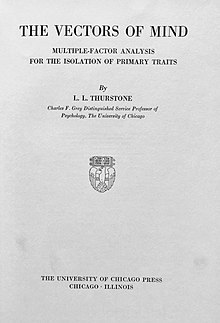The Vectors of Mind
The Vectors of Mind[1] is a book published by American psychologist Louis Leon Thurstone in 1935 that summarized Thurstone's methodology for multiple factor analysis.[2]
 | |
| Author | L. L. Thurstone |
|---|---|
| Country | United States |
| Language | English |
| Subjects | Factor analysis, psychometrics |
| Publisher | University of Chicago Press |
Publication date | August, 1935 |
| Media type | |
| Pages | 266 |
Overview
Thurstone's method for multiple factor analysis was first presented in a paper in 1931[3] but was further developed before the complete method was presented in this book. It relies heavily upon matrix algebra and gives a technical presentation of mathematical methods, including worked examples. His paper of the same name, published a year before the book,[4] had introduced several fundamental concepts of factor analysis, including communality, factor loadings, and matrix rank. The book introduced concepts of uniqueness, rotation, oblique factors, and simple structure. It also defined test reliability in terms of factor loadings. Fast electronic computers were not even imagined in 1935, and Thurstone's presents the centroid method of factor extraction which requires calculations that, while arduous, can be completed by hand. All the methods necessary to conduct a factor analysis with multiple factors, including both orthogonal and oblique rotation.
Historical context
In 1904 Charles Spearman published a paper that largely founded the field of psychometrics and included a crude form of factor analysis that attempted to determine if a single factor model was appropriate.[5] There was limited subsequent work on factor analysis until Thurstone published a paper in 1931 called Multiple Factor Analysis,[3] which expanded Spearman's single-factor analysis to include more than one factor. In 1932, Hotelling presented a more accurate method of extracting factors, which he called principal components analysis.[6] Thurstone rejected Hotelling's approach because it set the commonalities to 1.0, and Thurstone realized that will introduce distortions to the factor loadings when variables include unique components. Hotelling's method was also limited by the fact that it required too much calculation to be useable with more than about ten variables.[7] A year after Hotelling's paper, Thurstone presented a more efficient way of extracting factors, called the centroid method,[8] which allowed the factor analysis of a far larger number of variables. Later that year he gave his presidential address to the American Psychological Association wherein he presented the results of several factor analyses, including a factor analysis of 60 adjectives describing personality traits, showing how they could be reduced to five personality traits. He also presented analyses of 37 mental health symptoms, of attitudes towards 12 controversial social issues, and of 9 IQ tests.[4] In those analyses, Thurstone had made use of tetrachoric correlation coefficients, a method for estimating continuous variable correlations from dichotomous variables. Tetrachorics require extensive calculations but in early 1933, he and two colleagues at the University of Chicago published a set of computing diagrams that greatly reduce the calculations needed for those coefficients,[9] another aspect of making his method of factor analysis practical with more than just a few variables. His 1933 presidential address was published in early 1934 with the title Vectors of the Mind. It lacked methodological and mathematical details of his technique, which is then the subject of this book. A 2004 conference called Factor Analysis at 100 produced a book with two chapters that document the historical importance Thurstone's contributions to factor analysis.[10][11] Thurstone's approach to factor analysis remains an important method in psychological research and it has since been used in numerous other fields of study.[12] It is now considered part of a family of methods for analyzing the covariance structure of variables, which includes principal components analysis, exploratory factor analysis, confirmatory factor analysis, and structural equation modeling.[13]
Critical reception
External links
- Online Archive.org
- The vectors of mind: Multiple-factor analysis for the isolation of primary traits. APA PsychNET
References
- Thurstone, L. L. (1935). The Vectors of Mind. Chicago, Illinois: The University of Chicago Press.
- Wilks, S. S. Review: L. L. Thurstone, The Vectors of Mind . Bull. Amer. Math. Soc. 42 (1936), no. 11, 790--791. http://projecteuclid.org/euclid.bams/1183499382.
- Thurstone, Louis (1931). "Multiple factor analysis". Psychological Review. 38: 406–427.
- Thurstone, Louis (1934). "The Vectors of Mind". The Psychological Review. 41: 1–32.
- Spearson, Charles (1904). "General intelligence objectively determined and measured". American Journal of Psychology. 15: 201–293.
- Hotelling, H. "Analysis of a complex of statistical variables into principal components". Journal of Educational Psychology. 24: 417–441, 498-520.
- Harman, Harry (1976). Modern Factor Analysis. Third Edition Revised. Chicago, Illinois: The University of Chicago Press. p. 5. ISBN 0-226-31652-1.
- Mulaik, Stanley (2010). Foundations of Factor Analysis. Second Edition. Boca Raton, Florida: CRC Press. pp. 147–151. ISBN 978-1-4200-9961-4.
- Chesire, Leone; Saffir, Milton; Thurstone, L.L. (1933). Computing Diagrams for the Tetrachoric Correlation Coefficient. Chicago, Illinois: The University of Chicago Bookstore.
- Bock, Darrell (2007). "Rethinking Thurstone". In Cudeck, Robert; MacCallum, Robert C. (eds.). Factor Analysis at 100. Historical Developments and Future Directions. Mahwah, New Jersey: Lawrence Erlbaum Associates. ISBN 978-0-8058-5347-6.
- Bock, Darrell (2007). "Rethinking Thurstone". In Cudeck, Robert; MacCallum, Robert C. (eds.). Factor Analysis at 100. Historical Developments and Future Directions. Mahwah, New Jersey: Lawrence Erlbaum Associates. ISBN 978-0-8058-5347-6.
- Harman, Harry H. (1976). Modern Factor Analysis. Third Edition Revised. Chicago, Illinois: University of Chicago Press. pp. 6–8. ISBN 0-226-31652-1.
- Mulaik, Stanley A. (2010). Foundations of Factor Analysis. Second Edition. Boca Raton, Florida: CRC Press. pp. 1–3. ISBN 978-1-4200-9961-4.